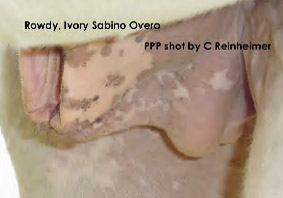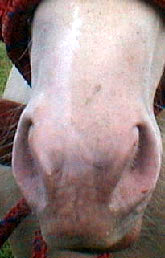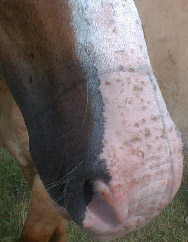The Creme Gene Ccr
What is a "creme gene" and how does it work?
Every horse has two locations in its genetic code where a certain type of color modification gene can reside. These genes are commonly called "creme" genes. They make the horse's base color one, or two, shades lighter, depending on whether there are one, or two, of them present.
Some horses, like sorrels/chestnuts, bays and blacks have no creme genes. We call these the base, or basic, colors.
Some horses, like palominos, buckskins and smoky blacks have one creme gene. They may be called "single dilutes."
Other horses, like cremellos, perlinos and smoky creams, have two creme genes. They are "double dilutes."
To see examples of
these colorations, please click on the links in the descriptions above, or
visit the Color
Chart . If You're not exactly sure what the differences between
Cremellos and Perlinos are, visit This Page.
The Facts and the Myths:
Presented here are several misconceptions about double dilutes, and the facts.
Misconception #1- "Double dilute"- Just a fancy name for an albino.
False- It is very important to note that the creme gene only makes the horse's color LIGHTER, but does not remove it, even when there are two present. They cannot make a horse an actual albino; it will always have pigment in it skin, hair and eyes. The only truly pink skin and white hair on a horse will be its MARKINGS, if any.


The first picture is of a sheath of an Ivory champagne overo horse (carries both the cremes gene and the champagne genes.) The second is the nose of a cremello colt that has white markings. They illustrate very graphically the difference in truely pigment free pink skin and pink skin that still has pigment.
Also, genes that cause albinism in other mammals are "recessive" genes, meaning they will not be expressed unless the animal gets 2 copies of the gene. The carriers of the "recessive" gene will not show any characteristics of the gene. In contrast, Creme genes are "incomplete dominant" genes, meaning they cannot be "hidden". A horse with one copy of the Creme gene will exhibit characteristics of that gene (i.e. palomino, buckskin coloring.) And thus far, research has not been able to find any albinos, or even albino genes, in the horse world!
Misconception #2- Because of thier pink skin, double dilutes sunburn easily and have increased problems with cancer.
False- Graphically illustrated above, there is a difference between pinks. What does this mean? It means that the rules reguarding bald faced white horses (like a mostly white paint) and sunburn do not apply to double dilutes. While no research has been done on the subject to date, owners of double dilutes who also have paints or other horses with large areas of white markings report that thier double dilutes sunburn much less frequently, if at all.

Picture of a red dun QH with a sunburned
nose
On the issue of cancers- there has been a lot of research done on this subject, and cancer HAS been known to be associated with certain breeds and colors. One of these breeds is NOT the "American Cream and white" (where many double dilutes of all breeds are registered.) As a matter of fact, pink or double dilute "pumpkin" skin was never mentioned in these studies as being at risk. The breeds with the most problems are appoloosas and draft breeds (associated with squamous cell carcinoma.) And the COLOR with the most cancer problems, to the point that several veterinarians have been quoted as saying "it's not if it's WHEN they get cancer" is grey (associated with melenomas).
Misconception #3- Double Dilutes are lethal whites that somehow survived, and may produce lethal whites.
False- Lethal whites are a product of a terrible gene (LWO) that is associated with the frame overo "paint" pattern. LWO, unfortunately, is not prejudiced, and attacks horses of all colors equally, sometimes even horses that appear to be solid, and therefore wouldnt be thought of as an "overo." For more information on this, please click on the link.
Misconception #4- If you breed double dilutes together you are going to wind up with weak horses with tons of problems.
False- creme genes DO NOT ACCUMULATE. You cannot have more than two creme genes in any horse. For this reason, breeding dilutes, or even double dilutes together will not increase the lightening of the skin, etc. It's essentially the same as breeding sorrels together: the resutling horse will be a sorrel, getting 2 red genes, one from each parent. Same principal when breeding cremes, just different colors. ALSO- Notice exactly what the creme gene affects: the color of the horse's hair, skin and eyes. Nothing else. It is the same horse with or without the creme genes, only the color is different: it has the same immune system, bone density, resistance to sunburn, stamina and every other strength it would have as a red, bay or black. Anything to the contrary has been disproved by experience and by experiment. If there were any doubts about this, one could just look at the many things that are done with people and thier Double Dilutes. To see these horses performing and proving this point- please visit our Performance Cremes page.
"But I've SEEN Albino Horses!" (Click link for more!)
The creme gene and Lethal whites (Click link for more!)
This page is not
intended to give the visitor a complete education in the science of
equine genetics, but merely to explain the creme gene in layman's terms,
and thus help dispel some of the myths associated with it. If you have
questions about these horses and their coloration please send an email and we will reply on the FAQ page..